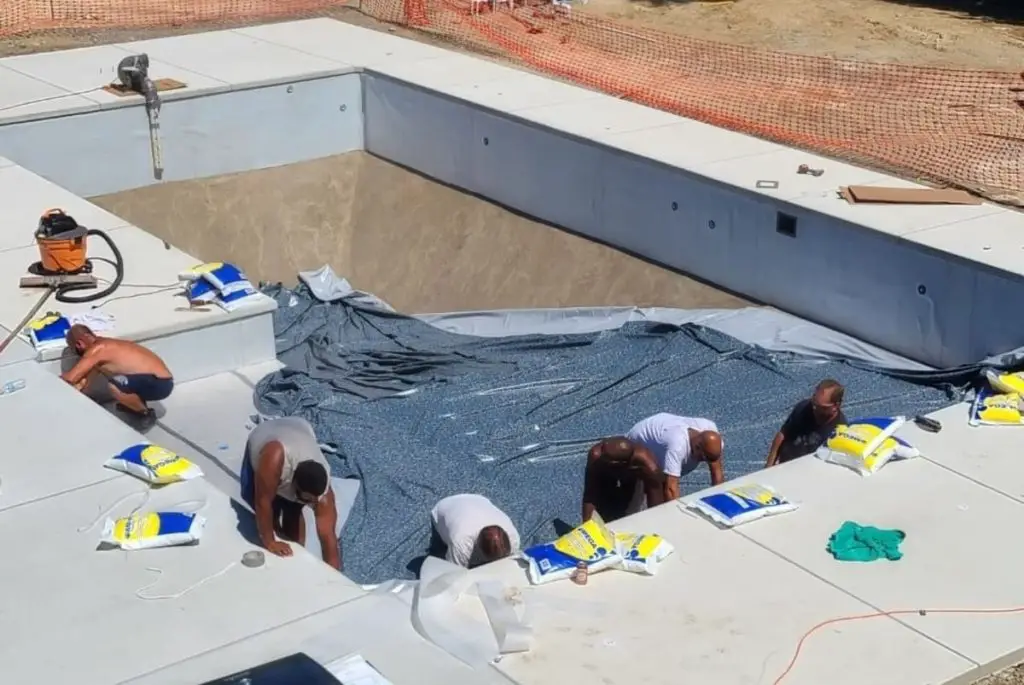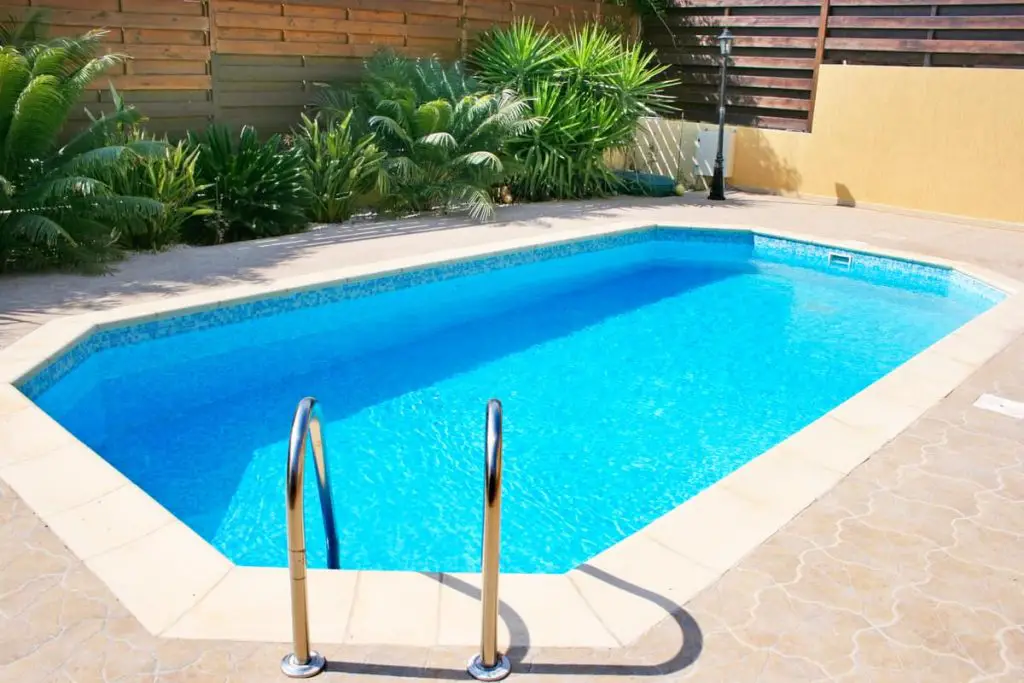Concrete pools can be an excellent option for your backyard. They are durable and will last for decades. But they aren’t the only options on the market. Liner pools are another popular pool type. This raises an important question. Does a concrete pool have a liner?
Most concrete pools won’t have a liner, because unlike typical vinyl liner pools they have a strong concrete shell. Therefore, there is no need to install a liner. However, if the concrete starts to crack or leak, some people will install a liner to solve this problem.
Whether you already own a concrete pool or are looking to buy one, you must understand the difference between different pool types. Keep reading to learn more about what separates concrete pools and liner pools.

Liner Pools Vs. Concrete Pools
Two of the most popular pool options are concrete and liner pools. These can both be good choices for your backyard. But what are the differences between them?
Concrete Pools
To build a concrete pool, you will need to spray a concrete component into the steel frame. Then, it will be left to harden, and this will often take a few days. At the end of this process, you will have a strong concrete shell. Once it’s set, it will be highly durable.
Once you have made the concrete shell, you will need to finish it off. This means adding in the plumbing. You’ll also need to decide what materials you want to use for the walls. There are a few options that you can explore. Some people like to use tiles, and others prefer stones. You can also paint the concrete.

Liner Pools
When building a liner pool, sometimes called a vinyl pool, you don’t need to create a strong concrete shell. Instead, thinner walls will be installed to frame the pool. However, a concrete beam runs around the outside of the walls to support them. Inside the pool, there will be a vinyl pool liner.
This fabric works by stretching over the walls. It then relies on the weight of the water to help it maintain its shape. However, you might need to replace the liner. Over time, it can grow wrinkled. The good news is that this is a relatively inexpensive process.
The Difference Between Concrete Pools and Liner Pools
Now that we know what each of these types is let’s look at some of their differences. This will make it easy for you to find which one you want to put in your home.
- Installation times- Concrete times will take substantially longer than liner pools.
- Cost-Liner pools are a lot less expensive to install
- Longevity-Concrete pools will be able to last for many years.
- Ability to customize the shape of the pool-When you purchase a concrete pool, there are no limits on the shape of the shell. This gives you dozens of options to explore.
- Cost to repair or replace-It’s a lot cheaper to repair a liner pool. However, you will need to do maintenance more frequently.
Do Concrete Pools Need Liners?
Often, a concrete pool won’t need to use a liner. Unlike vinyl pools, they aren’t made with walls. They have a strong concrete shell, and this creates a highly durable pool. You’ll need to exert a lot of force to crack a concrete pool. Though, as we’ll discuss, you will be able to convert your concrete pool to a liner pool if you want to.
Can You Convert a Concrete Pool Into a Liner Pool?
It is possible to convert a concrete pool into a liner pool. The main reason why people do this is that they have learned how expensive it is to maintain a concrete pool. In some cases, maintaining it can be half the cost of installing a new pool. This is a considerable expense, which many owners won’t be expecting to pay.
Another potential problem is that the pool has sprung a leak. This is rare for concrete pools, but it will be a significant problem that you need to overcome if it does happen. Identifying the cause of the leak will be tough. Then, you’ll need to fix it. By the time you’ve done this, you’ll have spent thousands of dollars. It can often be cheaper to convert it to a liner pool.

How Much Does it Cost to Convert a Concrete Pool into a Liner Pool?
There are a few elements that can affect how much it will cost you to make this conversion. These include;
- The size of the pool
- What condition it is in.
- Labor costs
- Expenses associated with ordering the material
There is a lot of work associated with making this conversion. For example, many of the concrete pools will have a rough surface on the walls and floor. This won’t be suitable for adding a liner, as it would scratch against the sides. Because of this, there is a chance that it will tear and rupture. To stop this from happening, they will need to sandblast the sides of the pool. This can be very expensive.
As a general rule, you can expect to pay at least $5,000 to $8,000. It’s best to talk to local contractors and a few companies to get a good idea of the work and the costs involved.

Pros and Cons of Converting a Concrete Pool to a Liner Pool
One of the most significant benefits of adding a liner is that you can change the texture of the pool. Some people find that concrete pools can be uncomfortable, scratching their skin. This is often a sign that it’s time to resurface the pool. You won’t have this problem with a liner. It needs to be a smooth surface. Because of this, adding a liner can be a good way of giving your pool a facelift.
Many people are attracted to adding a liner because they think it will be a cheap, quick way to solve an existing problem with their pool. However, this is not true. The underlying issues will still be there. Because of this, it’s usually best to bite the bullet and pay someone to fix your concrete pool.
Generally, it’s a fairly bad idea to convert your concrete pool into a liner. There are a few reasons for this. First, a concrete pool will last for a long time. But a liner will have a much shorter lifespan. This is because it’s rare to find a liner designed to be installed into a concrete pool. This is especially difficult if you have a novel shape in your pool.
Also, while a concrete pool and a liner can look similar, there are some substantial differences. As a result, installing the liner will be a lot of work. Not only will this be expensive, but it also increases the chances that the pool will start to leak.
Finally, prospective buyers will be able to spot a liner in a concrete pool. This can be a sign that there is something wrong with the pool. As a result, they will be able to negotiate a lower sale price.
Final Thoughts
There are a few substantial differences between concrete pools and liners. This can be seen in the way that they are constructed and how much maintenance they require. It’s rare to find a concrete pool with a liner. While you can add a liner to a concrete pool, it’s often recommended that you avoid doing this. It usually means that there are underlying problems, like cracks or leaks. It will be best to pay more to address these issues rather than patch them by adding a liner.
